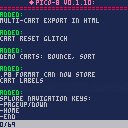So, I was looking at the manual (while I was working on a project), when I noticed the GPIO setup.
I just had the idea that if anyone owned 2 GPIO-capable devices, then couldn't that allow for networking? Sure, that does have a few issues:
- only 6 bits at a time (pCHIP has 6, but CHIP and RPI have 7)
- only 2 devices can be connected
But couldn't that work? Maybe Pong could work, as well as turn-based games.
If anyone has access to 2 of these devices, hopefully you can help me (I only have 1 RPI).
Controls:
x button(X) to select.
D-pad(Arrow keys) to move.
Pretty basic stuff, with an overworld and a (WIP)battle system.
Features:
-Calculates HP, MP, Speed, Strength, Defense, and gold.
-Saving and Loading (Though I'm not using it exactly.)
-Scrolling Overworld.
To-Do:
-Better Music.
-Better Graphics.
-Animation.
-Multiple Enemy encounters.
Leave feedback in the comments, and if anyone wants to take a shot at the music, go ahead. ;)


Here's a small suggestion: An option page!
1. To Activate
For the Web Player, I suggest we add a button. "Where can we add the button?", you may ask. There are two different methods for pausing: clicking on the screen, and pressing the button. I'd suggest we remove the button, and add a settings button!
The offline version, however, could use a command, such as "options", "settings", or "fix".
2. Suggested Settings
- Controls
- Fullscreen
- Audio Buffer (web only[If you can change that])
- Separate Pause Button (So players each have a pause button, but it does the same thing nonetheless.)
Thanks for your time!

Sometime ago, Josh Millard made the PICO Junior.
A few days ago, sta64 found out about PICO-8's Screen Resolutions.
I had the idea to combine the ideas, so I present the PICO Junior (Jr. for short) Challenge.
Requirements:
- 4 colors in total (transparency doesn't count)
- Must be 64x64
- One Player
Everything else? Fair Game.
To make sure that the games are easy to find, I've got 2 ideas:
- Put them all in this post.
- Tag them with "picojr".
I've got an example cartridge, lemme know which method would be easier.








Whenever I start up a game using the new web player, it says "future-version: 5", then after some time passes, I get "timeout :(". I figure I need to update the web player by clearing my cache, no biggie.
The new player gets to "loading cartridge..." then the web page crashes! (In Google Chrome, this is "Aw, snap!")
Offline carts still work, thank god.
Zep, don't sweat. Every game/program's pre-release stage is rocky.




Whenever you find a game that you like, but it's incomplete, what's an action you can take?
Refresh the Page.
Suddenly, you see it: The game has been refreshed.
"Refreshed" is sort of a modding series, where I take incomplete games and try to tidy them up.
Any game that I fix up will still retain the author's name, but I will add my own as well.
This enhanced version will also be posted in the original game's topic.
At the time of writing, I've got one in the works.
SPOILER ALERT:




(Sorry if this post gets a little rant-y!)
My suggestion is for one simple command:
cspr(x1,y1,id1,x2,y2,id2) |
mock-up of syntax
My reason:
When I had the idea to port my Gamebuino game, Smash and Crash, I thought this was going to be easy.
I was wrong.
The resolution nor the menus were not a problem, it was collision.
See, the Gamebuino's API had something nice about it: collideBitmapBitmap().
The command checks for two bitmaps, their x and y coordinates, and whether or not a pixel was overlapping.
With this, I was able to make collision very easily implemented.
In PICO-8 however, I find it to be very frustrating.
This is probably coming off as "I can't port my game, so you fix PICO-8 so I can.", isn't it?
Thanks for letting me waste your time(just don't look at it as "wasting").


I've kinds thought about this, but there aren't any true rules established, but instead just common sense.
I feel that should probably change.
So, I've got a short list of rules that I'd like you guys to read.
- No derogatory terms/imagery (racist terms, KKK stuff, et cetera).
- Cursing is allowed, but only in moderation. (Don't go on a raging session, folks.)
- No Spamming, trolling or excessive caps. (Trolling on the lines of asking questions like "Does a penguin fart?")
- Respect your fellow members and moderation team (whenever that happens).
- Post things in the correct category. By that, I mean:
Discussion is for general chatting, discoveries, and questions.
Editor is for the Editor, and the Editor only.
WIP holds incomplete carts and what-not.
Cartridges are where cartridges in a complete/presentable form are shown.
Collaboration holds topics for community/team projects.
Support is for problems with the PICO-8 Editor/Player itself.
The full cartridge size is 32 Kilobytes, but as many of us know, games come in all sizes.
Some games have expansive maps, while others have plenty of code.
Therefore, I propose a full token system.
- 3-4 sizes of maps
- Add a spritesheet at any time
- Have only the sounds you want
- Code would take the rest
I understand that this may take SERIOUS code restructuring, but it would be sweet.



So, I'm currently using the Jelpi demo program to make a new game, and I was wondering:
Is there anyway to have multiple small maps?
What I'm using right now is going to be where there's technically one map, but it's separated into chunks.
However, I'm not confident about that.
I am going to put the game on the site Soon-ish.


A while ago, Darkhog spoke of a large list containing codes for PICO-8.
Since I don't have a source of income right now, I decided to look for it.
I found it, and used elimination to snag me a copy of PICO-8.
For treasure hunt reasons, I can't say where this is.
All you gotta do is look ;)
But I hope to crank out some games quite soon!
The first being a remake of my Gamebuino game, Smash and Crash!
Thanks for being a great community!
Note:
This isn't a forum post saying "OMG PUT PICO-8 ON STEM NAOW!!!!", but rather a post on whether or not to do so.
This question was going to get asked eventually, so I thought I might do it.
Other engines, such as Game Maker have made it on Steam, so why not PICO-8?
PROS
- Would get more attention
- Steam Workshop could make it easy to get games
- Steam Discussion is pretty useful
- Paid games
CONS
- CoD Children might show up and say "THE GREEFICS LUK STOOPID"
- Valve gets a 10% cut of the profit (They're not bad people)
- The BBS would be useless as a result
- Again, Valve gets a cut
Think it over, but I could go either way...










Technical Side of Things
To run PICO-8 games, I'd imagine the system would be a Linux machine, with a customized OS that only has the dependencies, a theme that looks VERY similar to the PICO-8 start-up screen, and doesn't show output.
(Just a thought) All it would need are the dependencies required to run PICO-8, and a small amount of flash storage that holds the system information (saying this is a well-hacked up version of Linux), along with the PICO-8 software.
Outer storage would probably be best accomplished by an SD Card slot (or a Flash drive, if you wish). The outer storage would be used to hold the games (and I guess also update the firmware), but what should we do if there isn't one detected? We could either run one of the Demo games (kinda like the Sega Master System, but not hidden), or just show a screen that says "No SD Card found!".
Console Design
There are quite a few Microconsoles out at the time of this writing that look just like slabs of black plastic. LAME!














 0 comments
0 comments














